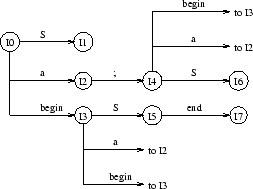Answer the following questions about the context-free grammar defined below.
The symbols ![]() , ;, begin, and end are assumed to be terminals.
, ;, begin, and end are assumed to be terminals.
We will work with the following augmented grammar:
![]()
![]()
![]()
![]()
First, we build
![]() , the collection of
, the collection of ![]() items for the augmented grammar: (the third
column will be explained later)
items for the augmented grammar: (the third
column will be explained later)
|
|
|
|
|
|
|
|
|
|
|
|
|
|
|
|
|
|
|
|
|
|
|
|
|
|
|
|
|
|
|
|
|
|
|
|
|
|
|
|
|
|
|
|
|
|
|
|
|
|
|
|
|
|
|
|
|
|
|
|
|
|
|
|
|
|
|
|
|
|
|

Then, we fill up the 'Action' part of the parse table, that is the part of the table from which, given a
state ![]() and an input symbol
and an input symbol ![]() , we will be able to know if we have to shift the input symbol and
with which state or if we have to reduce thanks to a particular production. In this last case, we push on
the stack the left-hand of the production with a state given by the 'Next' part of the parse table (part
that we will build afterwards). The state
, we will be able to know if we have to shift the input symbol and
with which state or if we have to reduce thanks to a particular production. In this last case, we push on
the stack the left-hand of the production with a state given by the 'Next' part of the parse table (part
that we will build afterwards). The state ![]() is built from
is built from ![]() . The analysis actions for the state
. The analysis actions for the state ![]() are determined as follows:
are determined as follows:
We need the following sets:
FOLLOW
![]()
FOLLOW
![]()
FOLLOW
![]()
For
![]() in
in ![]() , we have
, we have
![]() filled with 'reduce with
filled with 'reduce with
![]() '.
For
'.
For
![]() in
in ![]() , we have
, we have
![]() filled with 'reduce with
filled with 'reduce with
![]() '.
'.
Then we build the 'Next' part of the parse table. For state ![]() and for any non-terminal
and for any non-terminal ![]() , we have,
if
, we have,
if
![]() , alors
, alors
![]() .
.
This grammar becomes SLR(1) if we eliminate the conflict for ';' in ![]() by eliminating it from
FOLLOW
by eliminating it from
FOLLOW![]() .
.